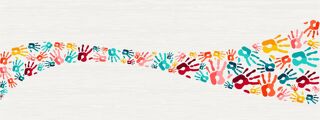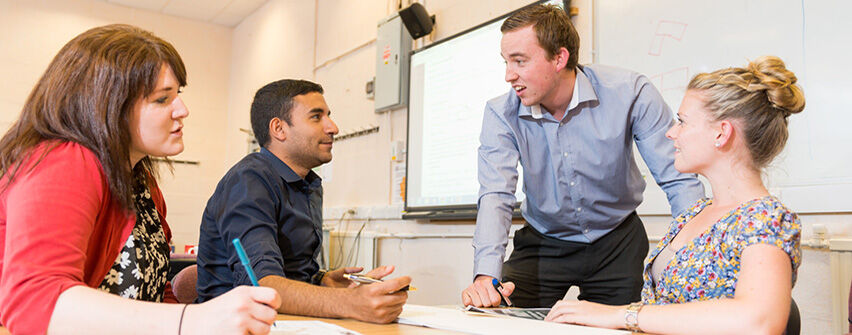The ‘Collaborative, Community Mapping of Young People’s Learning Experiences during COVID-19’ (Co-MAP) project is building a community of young people, researchers, school practitioners, families, community artists, charities, and street newspapers across five European countries. In the latest phase of the project, our CoMAP artists have worked with children and young people across four Birmingham ‘Schools of Sanctuary’: two primary schools, one secondary, and one college. In this blog we explore the latest phase of the project in dialogue with the work of bell hooks around liberatory pedagogies.
with Alex Kendall, Louise Lambert, and Louise Wheatcroft
‘Liberatory pedagogy really demands that one work in the classroom, and that one work with the limits of the body, work both with and through and against those limits’ (hooks, 1994: 138).
In Chapter 10 of ‘Teaching to Transgress’, bell hooks critiques ‘the erasure of the body’ (139) in teaching and learning spaces: calling for us to challenge the traditional arrangement of ‘passive bodies’ in the classroom as a way to build a productive teaching and learning community where everyone’s voice is listened to and that opens up space for the sharing of potentially hidden, emotive experiences.
The current phase of the CoMAP project, is framed within principles of participatory research and Rowsell’s ‘maker-space’ methodology, underpinned by ‘collaboration and connections with others’, that ‘privileges thinking through making’ (2020: 139). In this blog we turn hooks’s critique into an exploratory visual dialogue, drawing on examples from the latest maker-space phase of the CoMAP project, to explore how traditional classroom spaces and arrangements of bodies were disrupted and reimagined as part of the young people’s collaborative work with our CoMAP artists.
Mask making as ‘coming to voice’
‘Coming to voice is not just the act of telling one’s experience. It is using that telling strategically—to come to voice so that you can also speak freely about other subjects. (hooks, 1994: 148)
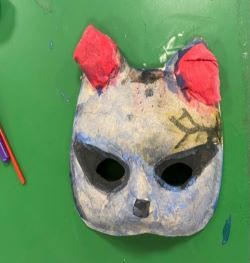
In this workshop, Year 5 and 6 children worked with artists, Mia Osborne and Polly Brant, to create masks to represent their feelings during periods of school closure and experiences of in/formal learning. This mask was created by a Year 5 girl who had only moved to the UK six months ago and had experienced lockdowns in another country. Whilst the front of the mask is very decorative and colourful, on the opposite side it is painted solely black. Safa (pseudonym) shared with the group that this represented the way in which she was hiding her feelings of sadness and loneliness during this time. She continued to share that she felt as if nobody liked her at this time as she didn’t have any contacts with friends: this was both a result of the pandemic and the living conditions that saw her family living in a temporary space.
Scapp (1994), in dialogue with hooks, calls for discussions around student voice to address uncomfortable questions around silencing, emphasising the responsibility of the teacher to cultivate a culture of listen to others seriously. In this workshop, there was certainly an atmosphere of careful, attentive listening as each child in turn shared the symbolism behind their mask designs.
‘Engaged’
‘“Engaged” is a great way to talk about liberatory classroom practice. It invites us always to be in the present, to remember that the classroom is never the same’ (hooks, 1994: 158).
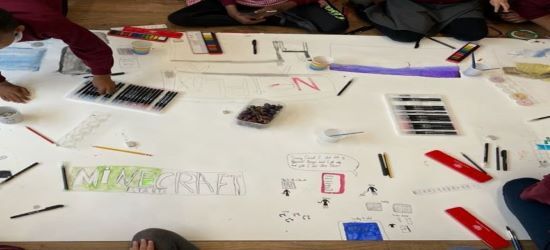
In this workshop, Year 5 and 6 children at another primary school worked with artist Marwa Sayed using watercolour paints as a medium to represent their experiences of learning during lockdown.
Before the session Marwa moved all of the furniture out of the way and laid out a long watercolour paper scroll on the floor and asked the children to work collaboratively on one sheet, sitting or lying on the floor as they wished whilst creating. By ‘returning to a state of embodiment’ (139) hooks proposes that we are able to deconstruct traditional orchestrations of power that denies the subjectivity of some groups. In this workshop, the purposeful disruption of the traditional classroom space appeared to encourage the children to become attuned to their physicality in contact with the floor: against the institutional limits and expectations of the body in traditional teaching and learning situations.
Freedom and ‘fierce commitment’
‘It takes ‘a fierce commitment, a will to struggle, to let our work as teachers reflect progressive pedagogies’ (hooks, 1994: 143).
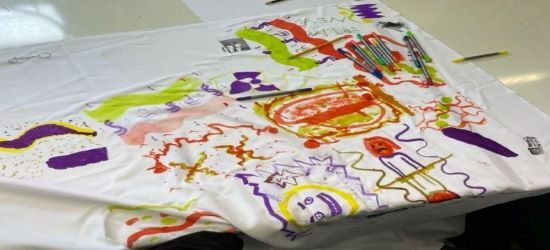
This idea of a fierce commitment on the part of teachers came to light in our workshop at the secondary school where the teacher had had to struggle against institutional constraints. In this case a reluctance from other staff members and/or school structures that appeared to connect to an underlying fear of allowing young people to be released from their core subject classes in case it impacted upon their achievement levels. It was only through the perseverance of this teacher, who had to address additional challenges of late room changes and the need to bring in a cover teacher, that enabled the workshop to go ahead.
Once the maker space was in action, artist Larissa Shaw, encouraged the young people to experiment freely with designs for the textile printing: a process that encouraged freedom of expression over aesthetic precision. On a large shared piece of textile, the young people contributed abstract pieces as well as more tangible-related images, such as times with particular family members, or symbolic representations of feelings through facial expressions.
An invitation
The three examples above appear to speak to aspects of hooks’s call for ‘liberatory pedagogy’: through the mobilising of bodies, encouragement of individual voice accompanied by attentive group listening, experimental intra-actions with materials, and a strength of belief in the creative work on the part of the teacher.
Throughout the conference, the CoMAP team invite you to engage with our CoMAP exhibition in the City South reception area: to intra-act with sensory materials, and to respond to provocations around liberatory pedagogies and of your own experiences of learning-teaching-caring during Covid-19. We also invite you to call in to the digital animation workshops that the CoMAP artists will be running with the young people on both days so you can see and sense their work in action.
References
hooks, b., 1994. Teaching to Transgress. Routledge.
Pahl, K. and Rowsell, J. 2020. Living Literacies: literacy for social change. MIT Press.
